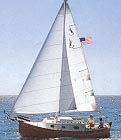 The Comfortable Pocket Yacht
The Comfortable Pocket Yacht 
|
|
|
Trailer Sailing |
The Basic Requirements Prior to this time, I had only day sailed three times on a captained 35 foot cruiser in the US Virgin Islands. While I could dream of this much luxury, my checkbook and common sense was convinced me that 35 feet of Blue Water cruiser was not a reasonable choice for a first boat. The concept of chartering was very attractive; however, the expenses involved in chartering an ocean capable cruiser for significant periods of a full year did not seem viable. I knew that I would have to scale back to get started. My other sailing experience was with a 17 foot folding Sea Kayak. With my wife’s sewing skills and a few pieces of wood and aluminum, we had built a sail rig with lee boards for this boat. Experience had shown that this was really too limited for what I wanted to accomplish. Where to get started – that is the real question. I needed to determine if this "sailing thing" was real for me or just something I had to get out of my system. Over the years, I had seen several stories about the Flicka 20 built by Pacific Seacraft. This design by Bruce Bingham with more than 400 built to date had often been described as one of the most capable small Blue Water cruisers ever built. It was said that there was no major body of water that had not been crossed by a Flicka 20 and returned safely. With an overall length of about 24 feet and an 8 foot beam, it was even trailerable (if you could tow 10,000 pounds). While this seemed to be an exact description of what I was looking (except for the weight) for, it still seemed questionable as a first boat. I settled on a goal of obtaining a pocket cruiser that was trailerable by my current vehicle (a Nissan Pathfinder with a 3.0 liter V6 engine and 4 wheel drive), stable under adverse sea conditions, comfortable for extended voyages of one week or more for one or two adults, and easy to singlehand. Performance was never a concern; after all, I had a whole year without a deadline in sight. I defined comfort as having sufficient cabin space to accommodate two adults and supplies for up to one week of self-sufficiency. Other requirements included sufficient electrical power for interior lights, stereo radio and CD player, a small television, marine VHF radio, limited cooking facilities similar to camping, a port-a-potty, and a collection of books. I did not wish to purchase a new boat. After all, the local brokerage had so many used boats available at relatively low prices. I wanted to limit the initial cost of the boat, motor, and trailer to $15,000 or less and hoped that this would be sufficient to purchase a relatively late model of "a boat that I can use". I also expected to spend an additional several thousand dollars on upgrades and maintenance to get to the level of "comfort" that I desired. Having set my basic requirements, I was off to the book stores and the Internet to collect as much information as possible. This page was last updated: 03/18/01 12:08:59 PM |
|
Copyright © 1998-2000 Jobst Vandrey |